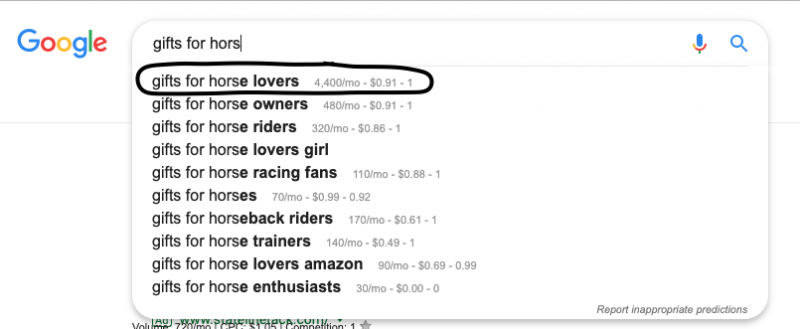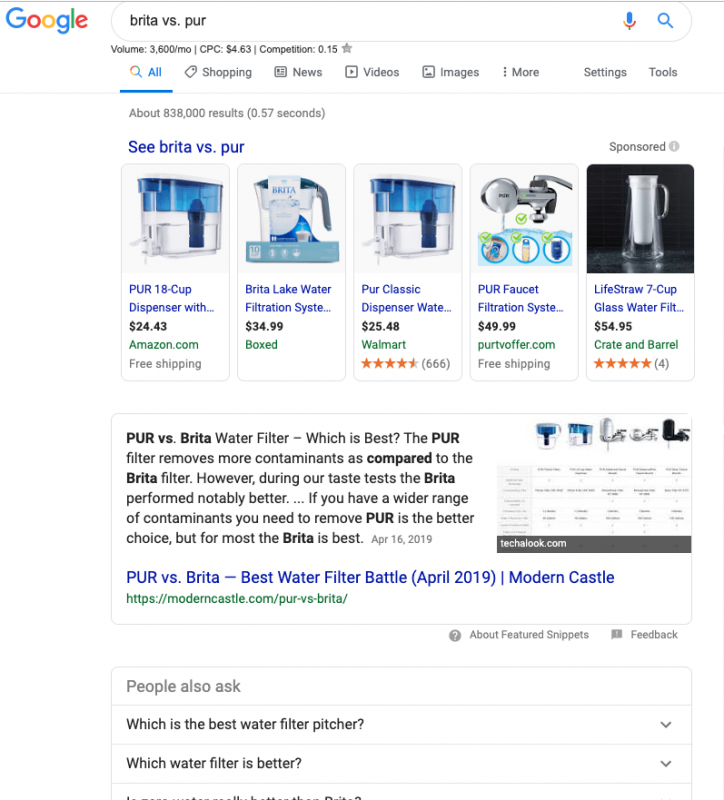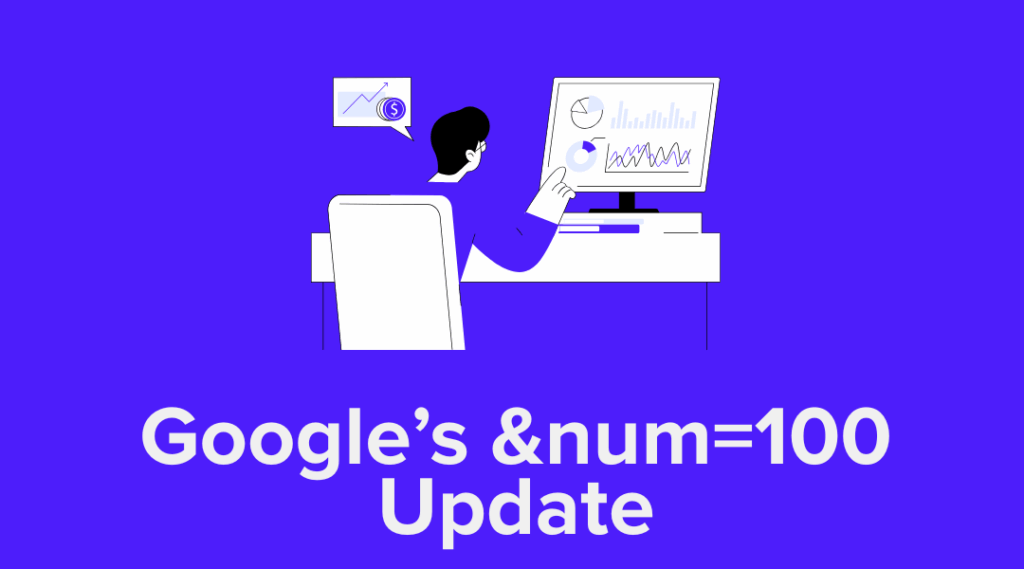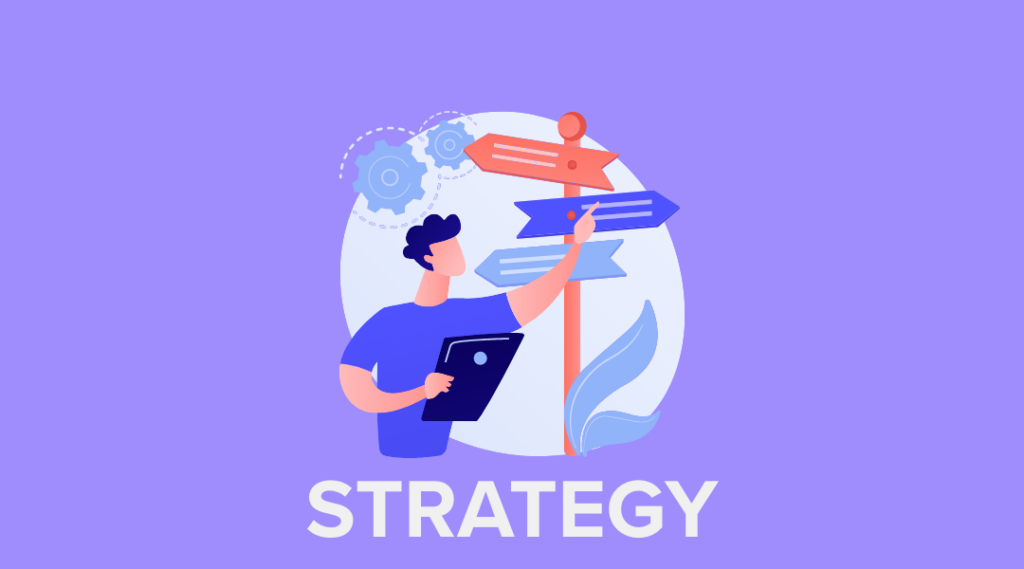Growing your ecommerce store doesn’t always have to mean adding new categories and product lines. A well-planned ecommerce content strategy can do more than grow your traffic, it can build trust, loyalty to your brand, and increase sales. We’re going to dive into some proven strategies for creating great content for your ecommence blog, and how you can use that content to scale your business.
Start With Your Keywords
You’ve got to love all the keyword opportunities you have with an ecommerce store. Category/collection keywords, sub-category keywords, and product keywords. Each of these pages allow you to focus on and go after very specific commercial intent queries.
It’s no different when it comes to your content strategy, we’re just transitioning to mid and top-funnel queries around your keywords.
Your content keywords are going to be built around your category and product keywords. For your content strategy, you will want to use your primary category/product keywords as your seed keywords. For example, if your store sells equestrian and horse tack supplies and one of your categories is “Equestrian Gifts” (720 searches per mo.), you could target this with the longtail “Gifts for Horse Lovers” in this case this query actually gets 4400 searches per mo. Unlike the purchase intent keyword, this SERP is content heavy and offers an answer box. This is connecting with your potential customers earlier in their buying journey.


For this query, you would want to do something like “21 of the Best Gifts for Horse Lovers”. Your post would obviously feature 21 gifts -- you may sell all of them, or it might be that you promote some products or experiences you don’t sell. This allows you to leverage other brand/product queries along with opportunities for further shares. Obviously, you want to do this in a way that doesn’t push your traffic to a competitor site.
As you form your content ideas around your category keywords you want to be planning out related content to form a strong internal link structure and move users through your site.
Learn more: Branded vs. Non-Branded Keywords: Which is Should You Prioritize For Your Website?
Pillars and Clusters for Ecommerce
There is increasing research around the pillar and cluster model for content. Others might call it hub and spoke, or creating neighborhoods of like content. In short, it is creating strong internally-linked content that all focus around a core topic or keyword.
For ecommerce think of your category page as your pillar. We’re going to create content that is related to our pillar keyword, these will be your clusters. Each of the clusters should be authoritative around questions or problems your buyers might be searching for in the lead up to them making a purchase from the target category. For example:
- Category: Refrigerator Water Filters
- Content clusters: How to Replace a Refrigerator Water Filter, Best Refrigerator Water Filters, What to do if Refrigerator Water Filter is Leaking, Buying a non-OEM Fridge Filter, etc...
This is just a few examples. Ideally, you’ll build up several articles answering all the questions around your category keyword.
You want to be thinking through each of the questions your customers could have, or what could be holding them back from making a purchase. Meet them on the results page with quality content addressing those questions. There are several studies that show that people need to be exposed to a brand up to 7 times before they make a purchase. Well thought out content is going to help you further expose your brand to customers.
Your content might bring them in at high and mid-funnel moments, when done well it is building trust. This is also creating a pool of warm visitors for retargeting ads.
Pro tip: AnswerThePublic.com is a great tool for helping you find questions around your seed keyword. Once you’ve got your list of ideas start testing in the SERPs to know what type of pages are ranking.
Linking Benefits of Pillars and Clusters
A strong internal link system is great for passing equity, increasing authority, and makes your site much more crawlable by search bots. Each one of your content clusters will be linking back to your target category page -- this helps to push a lot of equity back up into the category page raising its page authority.
If you have the ability to put related content/articles on your category page this also further helps with the internal linking and creating neighborhoods of related content. Not to mention making a better user experience with a stronger page.
You’ll also want to think about how you can link between content to help move users through your site. Perhaps they land in on a “How to” post, click through anchor text to “Best of” post, then into a category or product page.
When it comes to backlinks, let’s be honest… visitors to your site are going to be more compelled to share a great article that served as a resource or taught them something versus linking to or sharing a category page. If your posts get backlinks they’ll pass equity to your category page via internal links. This extra link juice helps to increase your page authority.
Learn more: How Long Does SEO Take to Work? Realistic Timeline for Results
Avoid Thin Content and Cannibalizing Keywords
When creating several pieces of content around the same keyword you have to watch that you’re not churning out thin content or cannibalizing another post or worse your category. Each post must be unique and should address a specific need for a user.
Identifying Thin Content Before it Happens
For example, if you were to write a piece on “how to replace a fridge water filter” then another piece on “when to replace a refrigerator water filter” you’re going to be somewhat cannibalizing your efforts. More so you’re likely going to be creating a shorter thin article that doesn’t really help the user. These topics are so close they should both make up one larger, more authoritative content piece. In short, each content cluster should be made up of several closely related questions/topics that are related to the overarching theme of the pieces.
Cannibalizing Your Keywords
If you target the same keyword with many pages and the content on each is similar in nature you’re going to be cannibalizing your keywords. When this happens Google struggles to identify the original/best page, and if Google is not able to identify uniqueness odds are none of the pages in that mix will rank.
Best Types of Content for Ecommerce Blogs
- How To posts
- Best Of posts
- Product Reviews/Guides
- Product Comparison
1. How To
What are the problems your customers have leading up to purchasing your products? Might they try and fix the problem before replacing the item? Or do they need help on how to use the specific product?
We’ll jump back to our equestrian ecommerce site example for this one. If your customer is going to potential spend several thousand dollars on a saddle you’ll want to have some top of the funnel yet authoritative content eg: “how to measure an English saddle”. This will become a resource you can link to that also benefits users and gives them confidence in the steps they need to take before buying a saddle online.
2. Best of
This is a great way to capture a buyer during the research process. Many times Google will also mix in content like this into commercial intent query result pages. The key to a best of post is being authoritative and being honest. A product is not simply the best because you happen to sell it, if there are other products you don’t carry that are also widely recognized as a “best” in your vertical, you’ll want to include them too. You don’t need to link to competitors but you still should give the product a shout out.
Our client FreshWaterSystems.com does some stellar “best of” content that checks all the boxes. Check out this Best of post for Undersink Water Filters. When your content is well researched and written like the example, Google rewards it with traffic.
3. Product Reviews/Product Guides
Best of content and product reviews/guides can sometimes get mixed. A product review or guide is diving deep into one specific product or product type. To do this you’ll need a product that is popular with enough search volume around it. You’ll want to hunt for those questions people are asking, perhaps “how does [product] work”, “how to install [product]”, “best uses for [product]”. By addressing common questions you’re helping to alleviate concerns buyers might have, you’re also displaying expertise in the product and showing your store as a trustworthy source for buying this product.
Wrapping in actual customer reviews you’ll further build trust. You can make this a hero piece for your product. Of course, don’t forget to create multiple opportunities for the reader to move from this page to the actual product page to purchase. Content like this is low funnel as the buyer has already identified the product they’re interested in.
4. Product Comparison
Product comparisons are a great opportunity for you to stack up your product next to other popular products you may (or may not) sell. It could be comparing it with a higher searched product that you can compete with. This is your opportunity to call out the pros and cons, what makes your product so great, perhaps areas that the competitors fall flat. It might even be a comparison of two products you sell – that is fine.
When doing a comparison you’ll want to find the top 2-3 direct competing products. Let’s say you sold water pitchers, this could be “Brita vs. Pur”, this gets 3600 searches per mo.

When I look at the results for this I see there is an answer box and PAAs here. This will eat some of that 3300 mo. search volume if you don’t rank the answer box. However, if you can get the answer box that’s a great traffic opportunity.
This result doesn’t have any videos showing, perhaps incorporating video into your post could put you ahead and Google may introduce the video comparison into the SERP.
Get Your Content Out There
As we mentioned at the start, people are going to be more inclined to share and link to your content versus a category or product page.
When researching and writing your content you should be formulating a plan for outreach and distribution. Don’t leave it as an afterthought.
Content Distribution
Once your new content is live don’t sit back, fold your arms and expect the traffic to come rolling in right away. There are a lot of factors that go into how quickly a piece of content will rank -- very rarely is it overnight. It can be weeks, more often months before it really takes off. This is why distributing your content and driving traffic in from non-organic channels is important.
- Social: Obvious but sometimes overlooked, or there is a disconnect between marketing teams and it doesn’t go out. Get your content scheduled to go out via all your social channels as close to publication date as possible.
- Email: Being an ecommerce you should have your email marketing in place, and if you’re really on top of it you’ve got your audiences segmented into lists. Get your content worked into your emails. The more pieces you create and to specific interest groups in your list the more value your emails can bring. Services like Klaviyo and MailChimp are great for setting up your email flows. Some content might even be good for your welcome series.
- Internal linking/Related articles: This is not distribution like the above, however, it is important that you go back into old articles that rank and link new content were natural or adds value. This can help pass users into new content. You’ll also want to have posts worked into your related content on homepage, categories, and products.
Content Outreach
Content outreach is going beyond the channels you control distribution. When planning your content you want to be thinking of who would be interested in the content, why they might be interested in your content (what’s in it for them), and can they help share it or would they be interested in linking to it.
Say you did a “Best of” post. You could reach out to each of the featured brands, will they share/distribute to their followers on social. Does it make their product look like a hero.
Perhaps it’s a “How to” post, what groups can you find on social to connect with and find people to help distribute.
Beyond social does your product have relevance to anything that’s going on in mainstream media? Perhaps it includes some unique research? Does it position you as an expert? Signing up to services like HARO (Help a Reporter Out) could help you find opportunities to connect with the media.
BuzzSumo is another great tool for helping you plan your outreach. You can look at competing content and find out who is sharing and linking to them. This could help guide your strategy for outreach.
Keep Your Audience First
When creating a content plan for your ecommerce site the biggest thing is to be mindful of is your audience. Is what you’re doing adding value, is it meeting the needs of potential customers. If you keep that central to why you're creating your content then the sharing and linking will come so much easier.
If you’re feeling stuck and need help with your content we’d love to help! We’ve created and guided content strategies for many ecommerce clients. Tell us more about your store and content issues. We’d love to connect.
Feature image courtesy of Vecteezy.





